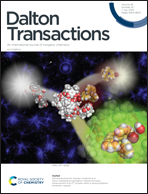Synthesis and characterization of heterometallic complexes involving coinage metals and isoelectronic Fe(CO)5, [Mn(CO)5]− and [Fe(CO)4CN]− ligands†
Abstract
The chemistry of coinage metal ions with Fe(CO)5, [Mn(CO)5]− and [Fe(CO)4CN]− has been explored using Mes3P and N-heterocyclic carbene supporting ligands. A comparison of [(SIPr)Au–Fe(CO)5][SbF6], [(Et2CAAC)Au–Fe(CO)5][SbF6] and [(Mes3P)Au–Fe(CO)5][SbF6] shows that the ligand donor strength towards Au(I) follows the order Mes3P > Et2CAAC > SIPr. These Fe(CO)5 complexes show significant blue shifts in ![[small nu, Greek, macron]](https://www.rsc.org/images/entities/i_char_e0ce.gif) CO bands relative to those observed for free Fe(CO)5 as a result of it serving as a net electron donor to Au(I). Au(I) is a much stronger acceptor in (SIPr)Au–Mn(CO)5 compared to Ag(I) in (SIPr)Ag–Mn(CO)5. The structural details of Mes3PAu–Mn(CO)5 are also presented. [Fe(CO)4CN]− afforded CN bridged coinage metal complexes with (IPr*)Au+, (SIPr)Ag+ and (SIPr)Cu+ moieties, rather than molecules with direct Fe/coinage metal bonds. The computed total interaction energies indicate that both [Mn(CO)5]− and [Fe(CO)4CN]− are stronger donors toward Au(I) than Fe(CO)5. A detailed analysis of the bonding interactions between the coinage metal ions and Fe(CO)5, [Mn(CO)5]− and [Fe(CO)4CN]− suggests that the largest contribution comes from electrostatic attraction, while the covalent component follows the Dewar–Chatt–Duncanson model. The σ-donor interactions of these organometallic ligands with coinage metal ions are considerably stronger than the π-backbonding from the coinage metal ions.
CO bands relative to those observed for free Fe(CO)5 as a result of it serving as a net electron donor to Au(I). Au(I) is a much stronger acceptor in (SIPr)Au–Mn(CO)5 compared to Ag(I) in (SIPr)Ag–Mn(CO)5. The structural details of Mes3PAu–Mn(CO)5 are also presented. [Fe(CO)4CN]− afforded CN bridged coinage metal complexes with (IPr*)Au+, (SIPr)Ag+ and (SIPr)Cu+ moieties, rather than molecules with direct Fe/coinage metal bonds. The computed total interaction energies indicate that both [Mn(CO)5]− and [Fe(CO)4CN]− are stronger donors toward Au(I) than Fe(CO)5. A detailed analysis of the bonding interactions between the coinage metal ions and Fe(CO)5, [Mn(CO)5]− and [Fe(CO)4CN]− suggests that the largest contribution comes from electrostatic attraction, while the covalent component follows the Dewar–Chatt–Duncanson model. The σ-donor interactions of these organometallic ligands with coinage metal ions are considerably stronger than the π-backbonding from the coinage metal ions.
![Graphical abstract: Synthesis and characterization of heterometallic complexes involving coinage metals and isoelectronic Fe(CO)5, [Mn(CO)5]− and [Fe(CO)4CN]− ligands](/en/Image/Get?imageInfo.ImageType=GA&imageInfo.ImageIdentifier.ManuscriptID=D0DT01590C&imageInfo.ImageIdentifier.Year=2020)


 Please wait while we load your content...
Please wait while we load your content...